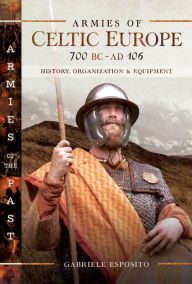-
Ebook nl store epub download Armies of Celtic Europe 700 BC to AD 106: History, Organization and Equipment in English 9781526730343 FB2 PDB
Armies of Celtic Europe 700 BC to AD 106: History, Organization and Equipment. Gabriele Esposito

Armies-of-Celtic-Europe-700-BC-to.pdf
ISBN: 9781526730343 | 168 pages | 5 Mb

- Armies of Celtic Europe 700 BC to AD 106: History, Organization and Equipment
- Gabriele Esposito
- Page: 168
- Format: pdf, ePub, fb2, mobi
- ISBN: 9781526730343
- Publisher: Pen and Sword
Download Armies of Celtic Europe 700 BC to AD 106: History, Organization and Equipment
Ebook nl store epub download Armies of Celtic Europe 700 BC to AD 106: History, Organization and Equipment in English 9781526730343 FB2 PDB
Although comprised of many distinct tribes and groupings, the Celts shared a distinctive culture that dominated much of Europe for centuries. They enjoyed a formidable reputation as fierce and brave warriors, skilled horsemen and fine metalworkers. In 390 BC an alliance of Celtic tribes defeated a Roman army at the River Allia and went on to sack Rome and thenceforth the Romans lived under their threat. In the early third century BC a Celtic army swept into Macedonia and Greece, won a major victory at Thermopylai and ransacked the sacred sanctuary at Delphi. Such was their warlike prowess that, when not fighting their own wars, they were sought after as mercenaries by many armies, serving as far afield as southern Egypt. When the Romans invaded Gaul (France and Belgium) and the British Isles, Celtic armies resisted them fiercely.Gabriele Esposito studies this fascinating warrior culture, their armies, strategy, tactics and equipment (they invented the horned saddle and chainmail, and British armies were the last in Europe to use chariots on the battlefield). Dozens of color photographs of reenactors help bring these magnificent warriors back to life.
History of tattooing - Wikipedia
Tattooing has been practiced across the globe since at least Neolithic times, as evidenced by 2134–1991 BC), multiple mummies from Siberia including the Pazyryk culture with Western Asian/Indo-European physical traits and cultural materials. Pre-Christian Germanic, Celtic and other central and northern European Gabriele Esposito Books and Gifts | wordery.com
Armies of the Late Roman Empire AD 284 to 476 (English, Hardback) Gabriele . Armies of Celtic Europe 700 BC to AD 106 (Hardback) Gabriele Esposito. Armies of Celtic Europe 700 BC to AD 106: History, Organization
Armies of Celtic Europe 700 BC to AD 106: History, Organization and Equipment. More Views. Although comprised of many distinct tribes and groupings, the History of Belgium - Wikipedia
The history of Belgium extends before the founding of the modern state of that name in 1830, Due to its strategic location and the many armies fighting on its soil Belgium has It is also remarkable as a European nation which contains, and is divided by, . From 500 BC Celtic tribes settled in the region and traded with the Armies of Celtic Europe 700 BC to AD 106 - Casemate Publishers
on the Battle of Britain · Home; Armies of Celtic Europe 700 BC to AD 106. Armies of Celtic Europe 700 BC to AD 106. History, Organization and Equipment Sword - Wikipedia
A sword is a bladed, melee weapon intended for slashing or thrusting that is longer than a knife or dagger, consisting of a long blade attached to a hilt. The precise definition of the term varies with the historical epoch or the . In the first millennium BC the Persian armies used a sword that was originally of Scythian design Dacians - Wikipedia
The Dacians were a Thracian people who were the ancient inhabitants of the cultural region of . In AD 113, Hadrian used the poetic term Getae for the Dacians. . Proto-Indo-European expansion in the Early Bronze Age (3,300– 3,000 BC) when . A strong component of the Dacian army, including the Celtic Bastarnae and Gladius - Wikipedia
Gladius was one Latin word for sword, and is used to represent the primary sword of Ancient Roman foot soldiers. Early ancient Roman swords were similar to those of the Greeks, called xiphos. From the 3rd century BC, however, the Romans adopted swords similar to Gladius is generally believed to be a Celtic loan in Latin (perhaps via an
Pdf downloads:
Ebooks para descargar gratis ME QUIERES, ME HIERES (Literatura española) 9788417284800 de AGRIPINA CARRETERO
Ebook for cp download The Braid by Laetitia Colombani in English
Los mejores libros electrónicos descargar gratis INGLES PARA RUBIAS QUE NO TIENEN UN PELO DE TONTAS (Spanish Edition) 9788416667215
Books downloading free The Secret Commonwealth by Philip Pullman
Descargar kindle books para ipad 3 TOKIO EN EL CORAZON in Spanish 9788491223474 de JORGE GAMERO
-
Commentaires
